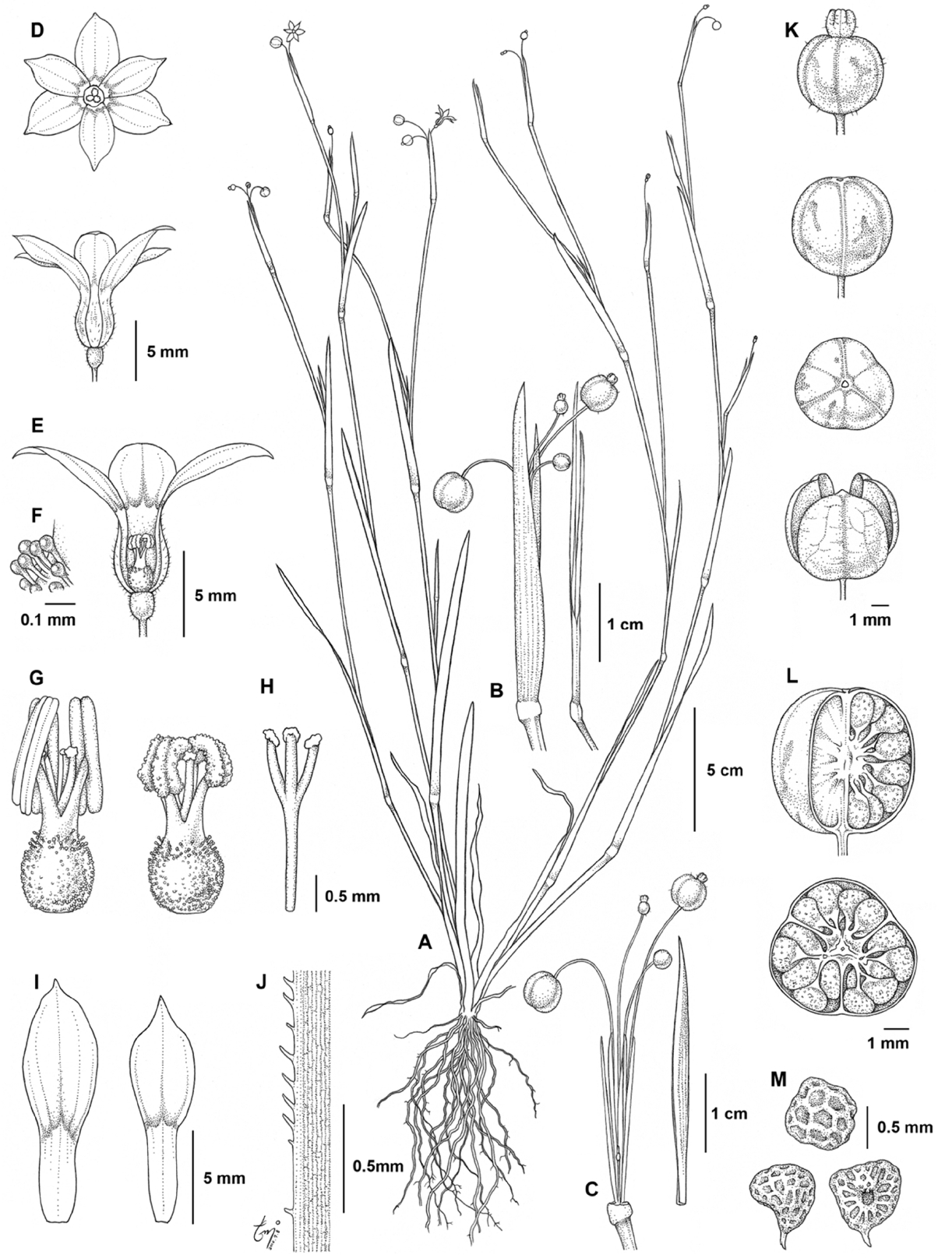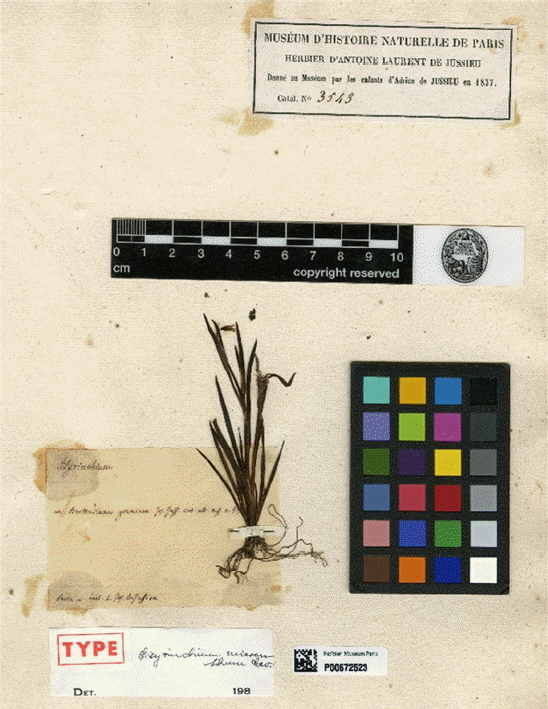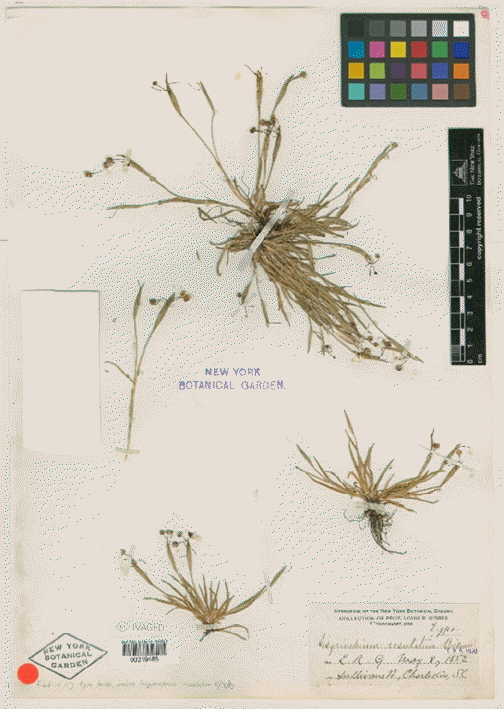한국 미기록 귀화식물 연등심붓꽃과 등심붓꽃의 분류학적 재검토
First report of a newly naturalized Sisyrinchium micranthum and a taxonomic revision of Sisyrinchium rosulatum in Korea
Article information
Abstract
제주도 서귀포시 일대에서 미기록 귀화식물 연등심붓꽃 (Sisyrinchium micranthum Cav.)이 발견되었다. 이 종은 중남미가 원산이며 여러 나라에서 침입종으로 보고된 바 있다. 연등심붓꽃은 국내에 먼저 보고된 귀화식물인 등심붓꽃의 자매종이며 두 종 모두 Echthronema 아속에 속한다. 연등심붓꽃은 화관의 밑부분이 긴 항아리 모양, 열매와 씨가 큰 점에 의해 등심붓꽃과 구별된다. 꽃이 연보라색이어서 국명을 연등심붓꽃이라고 신칭하였다. 등심붓꽃의 이전 학명인 S. angustifolium Mill.은 Sisyrinchium 아속에 속하는 종이며 형태적으로 등심붓꽃 (S. rosulatum.)과 매우 상이하다. 등심붓꽃의 학명을 기준표본, 원기재문, 최근의 논문들을 근거로 S. angustifolium Mill. 에서 S. rosulatum E. P. Bicknell 으로 변경한다.
Trans Abstract
Sisyrinchium micranthum Cav., a newly naturalized species, was found in Seogwipo, Jeju-do. This species is native to Central and South America and is reported as a widely invasive species around the world. Sisyrinchium micranthum is a sister species of S. rosulatum E. P. Bicknell (Deung-Sim-But-Kkot in Korean), reported as an invasive species earlier in Korea, and both species are members of the subgenus Echthronema. Sisyrinchium micranthum is distinguished from S. rosulatum by the urceolate shape of its flowers and by the large size of its fruits and seeds. Its local name is “Yeon-Deung-Sim-But-Kkot” based on the lavender color corolla. We also found that Sisyrinchium angustifolium Mill., previously used for Deung-Sim-But-Kkot, was misapplied. It belongs to the subgenus Sisyrinchium and is morphologically very different from S. rosulatum. We corrected the scientific name of Deung-Sim-But-Kkot by changing it from S. angustifolium to S. rosulatum based on the type specimens, original descriptions, and recent studies.
Sisyrinchium L. contains many species and it is the most taxonomically complicated genus in Iridaceae. The number of species in Sisyrinchium varies from ca. 60 to ca. 200 according to taxonomists (Rudall et al., 1986; Goldblatt et al., 1989, 2004). Sisyrinchium needs more research to resolve subgeneric divisions, identification of species, and synonyms for uncertain species (Goldblatt et al., 1990; Cocucci and Vogel, 2001; Souza-Chies et al., 2012; Alves et al., 2014). Most species are native to the New World and some species were reported as weedy and invasive plants in many countries (Esler and Astridge, 1987; Space and Flynn, 2002; Macdonald et al., 2003; Miyawaki and Washitani, 2004; Weber and Gut, 2004; Wu et al., 2004).
According to previous studies, genus Sisyrinchium was divided into two subgenera Sisyrinchium and Echthronema (Cholewa and Henderson, 1984; Rudall et al., 1986; Goldblatt et al., 1989, 1990; Cocucci and Vogel, 2001). Sisyrinchium micranthum Cav. and S. rosulatum E. P. Bicknell were assigned to subgenus Echthronema and they have partially fused filaments which is the main characteristic of subgenus Echthronema. These two species additionally have common characteristics of subgenus Sisyrinchium like blue to purplish tepals and basally cupped flowers (Goldblatt et al., 1990). Recent molecular studies have shown that S. micranthum and S. rosulatum were in the same clade and they were closely related (Chauveau et al., 2011; Karst and Wilson, 2012; Alves et al., 2014).
One species in genus Sisyrinchium, Deung-Sim-But-Kkot (S. rosulatum), was reported as invasive species in Korea (Chung et al., 1949; Jung, 1955). This taxon was found also in neighboring Japan and its scientific name has been commonly known as S. angustifolium Mill. in Korea and S. atlanticum E. P. Bicknell in Japan each. Both S. angustifolium and S. atlanticum are assigned to subgenus Sisyrinchium (Goldblatt et al., 1990). However, they have a fully fused filamental column which is the main characteristic of subgenus Sisyrinchium, and they are distinctly distinguished morphologically from Deung-Sim-But-Kkot.
Because of the morphological plasticity observed within S. micranthum and the lack of careful studies on S. rosulatum, the identification of the two species are often unclear and recent molecular studies suggested that both are a single species, i.e. S. micranthum (Chauveau et al., 2011; Tacuatiá et al., 2012; Tacuatiá et al., 2016). However, S. micranthum and S. rosulatum are native in Latin America and North America respectively (Cavanilles, 1788; Bicknell, 1899; Cholewa and Henderson, 2002; Goldblatt and Manning, 2008). Additionally, their morphological characteristics which are found in Korea show clear distinction in the size and shape of flowers, the height of plants, the width of leaves, and the size of fruits and seeds. In this paper, we report S. micranthum and S. rosulatum based on the type specimens (Figs. 1, 2), the original descriptions, and recent papers (Cavanilles, 1788; Bicknell, 1899; Chauveau et al., 2011; Karst and Wilson, 2012; Alves et al., 2014). We provide photographs to compare S. micranthum and S. rosulatum (Fig. 3) and the illustration of S. micranthum (Fig. 4).

Photographs of Sisyrinchium micranthum Cav. and S. rosulatum E. P. Bicknell. A. Habitat of S. micranthum. B. Two species in the same habitat. C. Flower comparison (from left to right) of S. micranthum (lavender type), S. micranthum (white type), S. rosulatum (purple type), and S. rosulatum (white type). D–F. Flower shapes, longitudinal sections of flowers, and fruit capsules of S. micranthum (left) and S. rosulatum (right). G. Seeds of S. micranthum (up) and S. rosulatum (down).

Illustration of Sisyrinchium micranthum Cav. A. Flowering individual. B. Inflorescence (fruiting). C. Inflorescence and inner spathe. D. Flowers. E. Longitudinal section of a mature flower. F. Oil-glandular trichomes on the base of filamental column. G. Filamental column. H. Style. I. Tepals. J. Leaf margin. K. Fruit capsules. L. Longitudinal and latitudinal sections of immature fruit. M. Seeds.
Some plants of S. rosulatum, which have white tepals, have been previously reported as new forma, S. angustifolium for. album J. K. Sim & Y. S. Kim in Korea (Sim and Kim, 1992). However, this new invasive forma reported is a white type of S. rosulatum or S. micranthum is not certain on account of lack of information in the voucher specimens and the original description. Consequently, we treat S. angustifolium and S. angustifolium for. album as synonyms of S. rosulatum.
Taxonomic Treatment
Sisyrinchium micranthum Cav. Diss. 6: 345, t. 191, f. 2, 1788; Marica micrantha (Cav.) Ker Gawl., Irid. Gen. 22, 1827; Bermudiana micrantha (Cav.) Kuntze Revis., Gen. Pl. 2: 700, 1891.–TYPE: MNHN-P-P00672523 (P).
Sisyrinchium iridifolium Kunth, Nov. Gen. Sp. 1: 324, 1816; Marica iridifolia (Kunth) Ker Gawl., Bot. Reg. 3: t. 229, 1817; Irid. Gen. 22, 1827; Bermudiana iridifolia (Kunth) Kuntze, Revis. Gen. Pl. 2: 699, 1891.
Sisyrinchium dichroum Poepp. ex Klatt, Fl. Bras. 3: 537, 1871.
Sisyrinchium fimbriatum Dombey ex Klatt, Fl. Bras. 3: 537, 1871.
Sisyrinchium micranthemum Pers., Syn. Pl. 1: 50, 1805.
Sisyrinchium micranthum f. eburneochraceum Ravenna, Onira 5: 57, 2001.
Sisyrinchium micranthum f. flavum Ravenna, Onira 5: 57, 2001.
Sisyrinchium micranthum f. luteum Ravenna, Onira 5: 58, 2001.
Sisyrinchium micranthum f. purpureum Ravenna, Onira 5: 57, 2001.
Sisyrinchium micranthum subsp. scudiculare Ravenna, Onira 5: 57, 2001.
Korean name: Yeon-Deung-Sim-But-Kkot (연등심붓꽃).
Herbs annual or short-lived perennial, 15–40 cm tall. Stems branched or rarely simple, flat, with 1–3 nodes, 1–3 mm wide, glabrous. Leaves alternate, ensiform, straight, 4–15 cm long, 3–6 mm wide, recurved at the apex. Inflorescences borne singly; spathes green, wider than supporting branch; outer spathes 2.5–4 cm long, 0.2–0.4 mm wide, margins basally connate 0.7–1.2 cm, 0–2 mm longer than inner one, apex acuminate, glabrous or hairy margin, hyaline margins of inner spathe ca. 0.3 mm wide. Flowers tepals lavender or white, with yellow center; flowers urceolate basally; outer tepals ca. 1 cm long, ca. 4 mm wide; inner tepals ca. 9 mm long, ca. 3 mm wide; filaments connate basally; glandular trichomes on the filamental column. Capsule ca. 5 mm in diam, globular, pubescent, or glabrous. Seeds ca. 1.1 mm long, alveolate, umbilicate, asymmetrically cuneate, and angled (Bicknell, 1899; Takeuchi et al., 2008). Chromosome number 2n = 16, 32, or 48 (Tacuatiá et al., 2016).
Voucher specimens: KOREA. Jeju-do: Seogwipo-si, Namwon-eup, Seoseong-ro 810beon-gil, 2, 16 Jun 2016, H. W. Shin, M. J. Kim & D. H. Kim s.n. (EWH); Seogwipo-si, Jijangsaem-ro, 331, 16 Jun 2016, H. W. Shin, M. J. Kim & D. H. Kim s.n. (EWH); Seogwipo-si, 516-ro, 463, 16 Jun 2016, H. W. Shin, M. J. Kim & D. H. Kim s.n. (EWH); Seogwiposi, Namwon-eup, 516-ro, 767, 16 Jun 2016, H. W. Shin, M. J. Kim & D. H. Kim s.n. (EWH); Seogwipo-si, 516-ro, 652, 16 Jun 2016, H. W. Shin, M. J. Kim & D. H. Kim s.n. (EWH); Seogwipo-si, 516-ro 771beon-gil, 200, 16 Jun 2016, H. W. Shin, M. J. Kim & D. H. Kim s.n. (EWH).
Collection site: Seogwipo-si, Jeju-do, Korea.
33°19′54.3″N 126°40′45.1″E, 33°17′26.3″N 126°33′10.2″E, 33°17′34.0″N 126°35′40.6″E, 33°18′58.0″N 126°35′48.7″E, 33°18′24.7″N 126°36′01.0″E, 33°19′45.2″N 126°35′06.3″E.
Habitat: Disturbed area including lawn, roadside, village green, and construction area. Sisyrinchium micranthum is commonly found along sunny roadsides.
Distribution: Native in Central and South America.
Naturalized in Australia, Japan, New Zealand, Samoa, South Africa, and United States.
Naturalized in Namwon-eup and the whole neighborhood, Seogwipo-si, Jeju-do, Korea.
Key to the species of genus Sisyrinchium in Korea
1. Leaves 1–2.5 mm wide; flowers campanulate basally; tepals purple, violet, or white; capsule ca. 3 mm in diam. ········································································ S. rosulatum
1. Leaves 3–6 mm wide; flowers urceolate basally; tepals lavender or white; capsule ca. 5 mm in diam. ················ ····································································· S. micranthum
Acknowledgements
This research was supported by the BK21 Plus Program (Creative Academy of Eco Science, 31Z20130012990) funded by the Ministry of Education and National Research Foundation of Korea. We thank Dr. Carol A. Wilson in University of California and Dr. Anita F. Cholewa in University of Minnesota.

